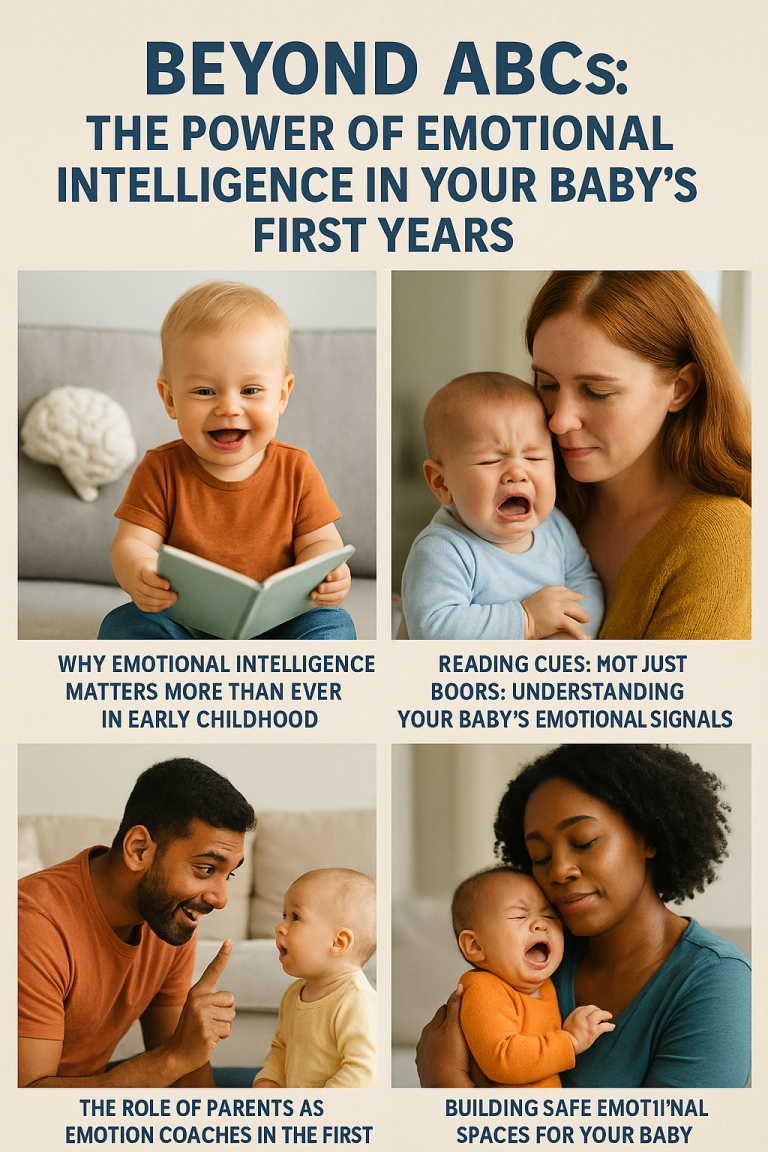
The Roots of Resilience: Why Emotional Intelligence Begins in Infancy
Before a child learns to crawl or utter their first syllables, a complex emotional world is already in motion. Infancy is not just a phase of physical dependency—it’s a crucible for emotional development. It’s where the seeds of empathy, self-awareness, and resilience are planted. The Roots of Resilience: Why Emotional Intelligence Begins in Infancy lies in the daily interactions a baby has with their caregiver. When a parent responds to a cry with gentle arms or mirrors a giggle with a smile, they’re wiring the brain for trust and safety.
At this early stage, the infant’s brain is building a scaffold of associations. Repeated soothing shapes stress response systems. Regular affection reinforces the sense of being worthy of love. Tiny moments—being held, cooed to, soothed—accumulate. Over time, they form a psychological bedrock that will support the child through every future challenge.
Heart Over Haste: Slowing Down to Understand Baby Emotions
Modern parenting often gets tangled in timelines. When should they sit up? Crawl? Talk? But in the race toward developmental milestones, something sacred is easily overlooked: the baby’s emotional tempo. Heart Over Haste: Slowing Down to Understand Baby Emotions is about shifting our focus from urgency to attunement.
Infants don’t cry for manipulation—they cry for communication. They express joy, confusion, overstimulation, or longing through the only language they know: feelings in motion. Slowing down means observing their micro-expressions, honoring their moods, and resisting the temptation to distract or dismiss.
When a caregiver tunes into the emotional frequency of their child—acknowledging tears, respecting silences, celebrating small joys—they build a deeper emotional dialogue. It’s less about solving every outburst and more about seeing the human beneath the behavior. This kind of presence doesn’t just comfort in the moment—it sets the stage for a lifetime of inner clarity.
Parenting with Presence: Becoming a Safe Space for Big Feelings
Children don’t need perfect parents. They need present ones. Parenting with Presence: Becoming a Safe Space for Big Feelings begins with one revolutionary idea: that emotional safety is more powerful than control. When a toddler screams, flails, or withdraws, they are not giving us a hard time—they are having a hard time.
Being present doesn’t mean being stoic. It means staying. Breathing. Sitting beside the storm instead of silencing it. It’s choosing empathy over efficiency.
In these charged moments, what the child seeks isn’t a solution. It’s you. Your calm eyes, your open posture, your unwavering love. When we let children experience the full spectrum of their emotions without shame, we teach them that feelings are not flaws. They are guideposts. And that home—both physically and emotionally—is where those feelings are always welcome.
From Cries to Connection: Decoding Early Emotional Language
Long before vocabulary, babies are speaking to us. Every sigh, squirm, squeal, and stare holds meaning. From Cries to Connection: Decoding Early Emotional Language invites caregivers to become emotional linguists—to listen between the lines, to translate the unspoken.
A shrill wail in the evening? It could be overstimulation. A furrowed brow during play? Perhaps a new sound was startling. That soft coo paired with wide eyes? It’s a cue for connection.
These tiny clues form the foundation of emotional communication. When we respond not just with functionality—diaper, bottle, nap—but with curiosity and warmth, we affirm the child’s sense of being understood. This mutual decoding grows into empathy. And empathy is the cornerstone of every thriving relationship they’ll build in the years to come.
The Empathy Blueprint: Modeling Emotion for Mini Minds
Children learn far more from what we do than what we say. The Empathy Blueprint: Modeling Emotion for Mini Minds hinges on our willingness to be emotionally honest. They watch us navigate frustration, joy, disappointment, and hope—and in that watching, they learn.
Saying “I’m feeling overwhelmed, so I need a moment to breathe,” or “I’m proud of you and that makes my heart full,” offers more than just language. It offers permission. Permission to feel deeply. Permission to name those feelings. Permission to make space for others’ experiences.
Empathy isn’t taught through instruction—it’s absorbed through demonstration. When children see caregivers offer kindness to a struggling friend, apologize with sincerity, or listen with undivided attention, they file away the template. And slowly, that template becomes their default.
Tiny Tools, Big Impact: Everyday Practices for Raising EQ-Rich Kids
You don’t need a PhD in child psychology to raise emotionally intelligent humans. What you need are rituals of connection—small, repeatable gestures that turn into lifelong skills. Tiny Tools, Big Impact: Everyday Practices for Raising EQ-Rich Kids includes things as simple as narrating your emotions aloud: “I’m smiling because I feel happy,” or “I’m frowning because I feel confused.”
Storytime becomes emotional literacy when we ask, “How do you think the bunny felt when he lost his hat?” Dinnertime becomes reflection when we prompt, “What was your favorite feeling today?”
Even routines—like saying goodbye in the morning—become emotional anchors when paired with affirmation: “I’ll miss you, and I love you, and I can’t wait to hear about your day.”
These are the tools. They don’t require fancy tech or big budgets. Just intention, patience, and a willingness to see emotional development as equal in value to academic or physical milestones.
Beyond the Meltdown: Teaching Self-Regulation Without Shame
Meltdowns happen. They are not moral failings. They are emotional explosions from a nervous system still under construction. Beyond the Meltdown: Teaching Self-Regulation Without Shame means reframing these outbursts not as bad behavior—but as cries for help.
Shame shuts down learning. It teaches children that their emotions make them unlovable. But when we approach the meltdown with compassion—offering calm, closeness, and clear boundaries—we teach something far more powerful: self-regulation.
We might say, “It’s okay to be upset. I’m here to help you feel safe again.” Or “You’re having a big feeling, and I will stay with you while it passes.”
Over time, the child internalizes our calm. They begin to build their own toolkit: breathing, naming, pausing, choosing. Emotional mastery doesn’t come from punishment. It comes from repeated, loving guidance through the emotional storm.
The Long Game of Emotional Intelligence
The goal is not to raise a child who never cries, never screams, never feels big things. The goal is to raise a human who knows what they feel, why they feel it, and what to do next—with empathy, courage, and clarity.
Emotional intelligence is not a luxury. It’s a survival skill. It’s the invisible glue in friendships, partnerships, leadership, and self-worth. It’s how we bounce back from failure, connect across difference, and navigate life’s inevitable heartbreaks and triumphs.
By prioritizing emotional development from the earliest days, we’re not just shaping childhood—we’re reshaping society.
A Final Thought: Holding Space for Tiny Hearts
Children are born whole. They are not blank slates but rich, radiant beings filled with emotional potential. Our role is not to mold them into perfection. It is to witness them. To guide them. To reflect back the worth they already possess.
We don’t raise emotionally intelligent kids with checklists. We raise them with presence, patience, and love. And when we do that—consistently, imperfectly, and wholeheartedly—we raise humans who will feel deeply, love wisely, and thrive unapologetically.
Feel first. Thrive forever.




